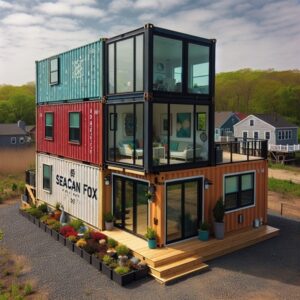
Key Takeaways
- Choose a shed-style, gable, or flat roof for your container home to ensure it withstands heavy snow.
- Insulation and ventilation are crucial to prevent condensation and maintain warmth.
- Regular maintenance is essential for extending the lifespan of your container home’s roof.
- Consider eco-friendly options like solar panels and green roofs for added sustainability.
- Consult with experts to select appropriate materials and designs for your specific climate.
Built to Last: Snow-Proofing Your Container Home Roof
When we talk about container homes, we’re discussing a revolution in housing that combines sustainability with affordability. But let’s not forget, these steel boxes were originally designed to withstand the high seas, not necessarily the weight of a heavy snowfall. That’s why, when it comes to roofing, we need to think about durability and safety. It’s not just about keeping the cold out; it’s about holding the weight of snow up.
A Wall Against the Weather
The first step in snow-proofing your container home is to choose a roof that can act as a fortress against heavy snow and ice. This means considering the shape and materials of the roof, as well as the specific weather conditions of your area. You want a roof that not only complements the design of your container home but also stands up to Mother Nature’s tests.
My Favorite Container Homes Resource
I compared the top 3 Container Home Guides
to discover the ultimate resource!
See my top recommendation here
Materials Matter
Now, the materials you choose for your container home’s roof will make all the difference. You’ll want something that’s not just tough, but also insulative. Snow and ice can be insidious, finding their way into the smallest gaps and causing rust or worse. Therefore, picking the right materials is not a decision to take lightly.
The Blueprint for Success
Let’s dive into the nitty-gritty of the roofing styles that will keep your container home cozy and intact, even when the snow is piling up outside.
The Shed-Style Roof Advantage
A shed-style roof is a single-plane sloping roof that is higher on one side than the other. It’s a simple design that’s effective at shedding snow and preventing accumulation. Because of its simplicity, it’s also one of the most cost-effective options to build and maintain.
Slope and Snow Load
The slope of your shed-style roof is critical. A steeper slope means that snow will slide off more easily, reducing the weight and stress on your roof. But there’s a balance to be struck here: too steep and you’re losing out on potential living space; too shallow and you risk a snow overload.
Overhang and Insulation
Let’s not forget about the overhang. Extending the roof beyond the walls of your container home can prevent water and snow from creeping in. And insulation—well, that’s a game-changer. It keeps you warm, sure, but it also stops ice dams from forming, which can cause real trouble for any roof.
Gable Roofs: A Classic Choice
Gable roofs are the ones that look like an A-frame on top of your home. They’re great for snow because they have two sloping sides that come together at a ridge, creating a shape that naturally sheds snow. It’s a classic for a reason—it works.
Design Details for Snow
When you’re planning a gable roof for snow, you need to think about the pitch and the materials. A metal roof with a slippery surface can help snow slide right off, while the pitch will determine how quickly it slides. You’re aiming for a sweet spot where snow doesn’t linger, but also doesn’t slide off so fast it creates a hazard below.
Ventilation Vitality
Good ventilation in a gable roof helps to regulate the temperature. This is important because if your roof is too warm, it can melt the snow unevenly, leading to ice dams. These are ridges of ice that form at the edge of a roof and prevent melting snow from draining off. Not good. So, we ventilate to keep the temperature just right.
Flat Roofs: Modern and Sleek, but Beware
Flat roofs might give your container home a modern edge, but they require careful consideration in snowy climates. Without a slope to help shed snow, you’ll need to be proactive in your design and maintenance to prevent problems.
When Flat Makes Sense
In areas with less snowfall, a flat roof can be a stylish and practical choice. They’re easier to construct and can even support a rooftop garden or deck. But if you’re buried in snow each year, you might want to think twice or be prepared for regular snow removal.
Proactive Protection Measures
For those committed to the flat roof aesthetic, you’ll need to be vigilant. This means regular inspections and a robust maintenance routine. Snow removal should be done carefully to avoid damaging the waterproof membrane that’s crucial for keeping your home dry.

| Roofing Style | Key Considerations | References |
|---|---|---|
| Shed-Style Roofing | – Involves welding steel plates across the container and attaching wooden beams to support the roof trusses – Provides a sloped roof that can be covered with shingles or metal sheets – The roof should overhang the container to allow for ventilation | 1, 5 |
| Gable Roofing | – Creates a traditional triangular look and provides good water drainage to prevent leaks – Installation process is similar to shed-style, requiring steel plates, wooden beams, and trusses – Ventilation is important at the gable ends | 1, 5 |
| Flat Roofing | – The container’s existing roof can be adequate, but this leaves it vulnerable to water pooling – Adding a tarpaulin and asphalt layer can provide some protection – A sloped roof is generally recommended for better drainage and longevity | 1, 3, 5 |
| Structural Considerations | – It’s crucial to work with a structural engineer to ensure the roof meets load-bearing requirements and the overall structure is safe and durable – Proper maintenance, such as removing snow and debris, is key to extending the lifespan of a container home’s roof | 1, 2, 3 |
| Ventilation | – Proper ventilation is important for all roofing styles to prevent moisture buildup and ensure the structure’s longevity | 1, 5 |
Incorporating Eco-Friendly Features
As we build our homes, it’s not just about standing up to the weather; it’s about respecting our planet. That’s why incorporating eco-friendly features into your container home’s roofing is a smart move. It’s a win-win: you get a durable, weather-resistant roof that also lowers your environmental footprint.
Solar Panel Integration
Imagine your roof not just as a shield, but as a power generator. Solar panels can turn that empty space into a mini power plant, soaking up the sun’s rays and slashing your electricity bills. But there’s a trick to it—you’ve got to position them just right for maximum efficiency, and make sure they can handle the weight of the snow.
- Consult with a solar expert to find the best placement for your panels.
- Choose solar panels that can withstand heavy loads, especially if you live in a snow-prone area.
- Ensure your roof structure is reinforced to support the additional weight of the solar panels plus snow.
Besides that, by integrating solar panels, you’re not just cutting costs—you’re also cutting carbon emissions. It’s a step towards self-sufficiency and a nod to the health of our environment.
Green Roofs and Rain Collection
But why stop at solar power? Let’s talk about green roofs—these are roofs that are partially or completely covered with vegetation. They’re like a park on top of your house! Not only do they look amazing, but they also provide extra
And when it comes to water, let’s not forget rain collection systems. These can be as simple as barrels that catch runoff from your roof or as complex as integrated systems that filter and store water for later use. In snowy areas, melting snow can provide a surprising amount of water.
So, with a little ingenuity, your container home’s roof can do more than just protect you from the elements—it can nourish your garden, lower your utility bills, and even provide emergency water supplies.
Wrapping It Up: Your Roof, Your Fortress
Your container home’s roof is more than just a cover; it’s the guardian of your abode. By choosing the right style, materials, and eco-friendly features, you’re not just building a home—you’re crafting a personal fortress that stands up to snow, reduces your environmental impact, and even gives back to you in energy savings and beauty.
Remember, the roof you choose will shape your container home’s character and resilience for years to come. So take your time, weigh your options, and make a choice that you’ll be proud of every time you look up.

Frequently Asked Questions
In this section, let’s address some of the common questions you might have when it comes to snow-proofing your container home’s roof. I’ll give you straightforward answers that will help you make informed decisions for your unique situation.
Whether you’re in the planning stages or looking to retrofit your existing container home, these answers will guide you towards creating a roof that’s not only durable but also safe and sustainable.
So, let’s tackle these questions one by one and get you on the path to a snow-proof, secure container home.
How Much Snow Can a Container Roof Handle?
It all depends on the design and materials. A well-designed gable or shed-style roof can handle a lot of snow, especially if it’s made of strong materials like metal and has a steep pitch. Flat roofs are more vulnerable and require diligent maintenance to stay ahead of heavy snowfall.
Do I Need a Special Permit for a Snow-Proof Roof?
In most cases, yes. Building codes often have specific requirements for snow loads and roof designs, especially in areas known for heavy snowfall. Always check with your local building department before you start construction to ensure you’re in compliance and to avoid any legal headaches down the road.
Obtaining the right permit not only keeps you on the right side of the law but also ensures that your roof is built to a standard that can withstand the local climate challenges. It’s a crucial step in the process, so don’t overlook it.
Remember, the goal here is to create a safe and durable living space, and adhering to local codes is a big part of that. So, take the time to understand what’s required in your area and plan accordingly.
What Are the Best Insulation Materials for Cold Climates?
Insulation materials like spray foam, rigid foam boards, and fiberglass are all effective in cold climates. Spray foam, in particular, can provide an airtight seal, which is ideal for container homes. It’s important to choose insulation that not only retains heat but also manages moisture to prevent rust and corrosion.
Can I Collect Rainwater From My Container Roof in Winter?
Absolutely! Snowmelt can be a valuable source of water for rain collection systems. Just make sure your system is designed to handle freezing temperatures and is properly insulated. You’ll want to use materials that can expand and contract with the freeze-thaw cycle without cracking. For more information on suitable materials and techniques, check out our container home insulation review.
Additionally, consider a heated system to prevent ice blockages, which can damage your gutters and downspouts. With the right setup, you can turn the winter snow into a resource, rather than a roofing risk.
How Do I Maintain My Roof Throughout the Seasons?
Regular inspections are key. Look for signs of wear and tear, like rust or damaged insulation. Keep gutters and downspouts clear, and remove snow and ice accumulations promptly to prevent damage. And don’t forget to check your solar panels and greenery if you have them!
- Inspect your roof before and after the snow season to identify any potential issues.
- Clear snow and debris from your roof, gutters, and downspouts to prevent water damage and ice dams.
- Check the structural integrity of your roof regularly, especially after heavy snowfalls or storms.
- Maintain your solar panels and green roofing systems to ensure they continue to function efficiently.
- Consult with professionals for any repairs or maintenance tasks that are beyond your skill set.
By staying proactive with maintenance and weatherproofing, you can ensure your container home remains comfortable and resilient throughout its lifespan. It’s all about being vigilant and responsive to the needs of your home, so you can enjoy it for years to come.
There you have it, a comprehensive guide to snow-proofing and maintaining the roof of your container home. With these strategies in place, you can rest easy knowing your home is prepared to face the snowy seasons ahead.





